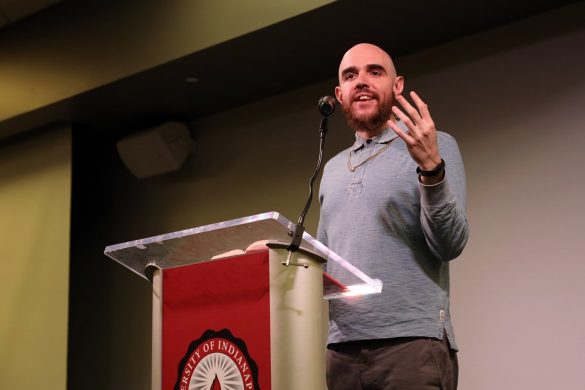![[From left to right] Mary Schreier, Emma Rund, Stephen Cox, James Leagre and Destiny Heugel perform a reading of “Mary’s Monster” during rehearsal on Oct. 29. Photo by Zoë Berg](https://reflector.uindy.edu/files/2017/11/IMG_9960-300x218.jpg)
[From left to right] Mary Schreier, Emma Rund, Stephen Cox, James Leagre and Destiny Heugel perform a reading of “Mary’s Monster” during rehearsal on Oct. 29.
Photo by Zoë Berg
“We spent the summer meeting about how the piece was going to be created and what the focus of it was going to be,” Leagre said. “One of the parameters that we talked about was that, because we’re looking at Mary Shelley, we wanted it to be female-driven. We went through a lot of different incarnations, and as we did research on Mary Shelley, her life just was unbelievable… We talked about trying to integrate Mary Shelley’s life into ‘Frankenstein’ [and] the Frankenstein story, and how does that kind of intertwine…. She [Peterson] has taken liberties in crossing over the real life of Mary Shelley and elements in the story of ‘Frankenstein.’”
“Mary’s Monster” follows the life of Shelley when she was 16 years old. At that time, Shelley was writing “Frankenstein” and dealing with many romantic and family issues, which the play touches on. “Mary’s Monster” focuses on the relationships Shelley has with her two sisters, her father and her future husband, as well as how life, death and pregnancy relate to that.
“She was this little fireball badass through the world,” Peterson said. “And the relationships with her sisters took a hold of the whole piece and you really get a sense of the unbelievable, volcanic gurgling inside this young woman, who is just like us, who had this crazy love affair that ignited inside of her and dislodged this amazing piece of fiction that really changed the way we view horror and the responsibility to our creations.”
Junior theatre major Mary Schreier plays Shelley and began working on “Mary’s Monster” at the beginning of the process as the dramaturge, meaning she helped research the time period and people to give Peterson a basis of knowledge for writing. She said she hopes the audience sees Shelley as a real person, as she has come to know her.
“She was a real person who went through real tragedies and had real relationships,” Schreier said. “She’s not holier-than-thou by any means. She’s not metaphysical. She’s not just a name on a paper. She’s not just an author, she is a person. And I think that’s what this play really can show. And if I could ask the audience to take anything away from that, it would be that she’s a person.”
Schreier said she enjoyed working with Peterson and being able to contribute to an original work. According to Schreier, it is a different type of process to perform something that has never been staged before.
“It’s interesting to be able to find the characters because you don’t have anything that can manipulate you in anyway,” Schreier said. “There’s no YouTube bootleg of anything. There’s no ‘Well, so-and-so did it better.’ It’s you. This is your interpretation of the character that is written down, and I think that makes it such an amazing process to be in the show.”
In a typical staged reading, performers are not fully costumed, there is no set and no sound effects or special lighting. Generally, there is just a narrator reading stage directions. Leagre said performers usually sit in a row of chairs on stage and come to the front of the stage to read their parts for each scene. However, “Mary’s Monster” is different; there are sound effects and lighting cues and it is performed on the same set as “Frankenstein.”
“I’ve created areas that are the different locations that the play takes place,” Leagre said. “So the actors migrate to those areas so that way at least there is a definition in terms of, ‘Okay, if they’re here we know they’re in the Wynn household; over here is the kitchen; over here is another character’s place.’ But I also decided, because K.T. had some very specific sound effects that were very integral to the story, to do sound effects to enhance the experience.”
Although Shelley first published “Frankenstein” anonymously, Peterson said Shelley would not have done so because she was embarrassed of her work or worried that it would not be accepted, but because it would be easier for people to believe a man could have written it. Leagre said at that time it was not acceptable for women to write much of anything, especially not science fiction or horror. Peterson said she hopes one day people will be able to look at works by underrepresented people without seeing that label, but seeing the work itself.
“Wow, wouldn’t it be great one day when we approach anything that is thriving and see it as it is, rather than making excuses for it, like a black writer writing a play rather than an amazing writer writing a play?” Peterson said. “We are all running the same race. We have a long way to go, but we do need to make room to advise the past. People do need to make room, making room that is not editing and making less of, it is acknowledging Mary Shelley for her contribution, and her mother before her, in times that ‘there is no room for people like that.’ Mary was one of a long line of shoulders that had been standing on themselves that moved through this world anonymously. And because of that, I get to write this play, I get to go to school for what I want and marry who I want. I want people to look at her as a writer and look at what was happening in history at that time.”









